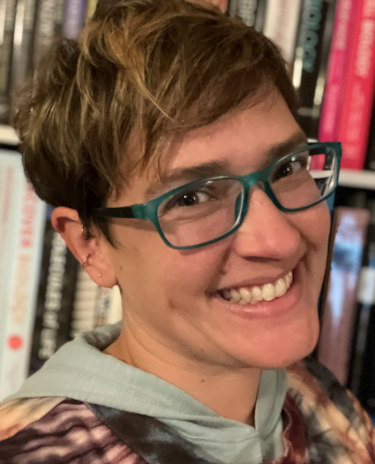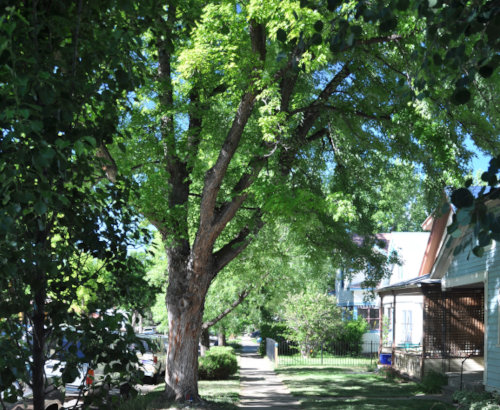By Field Peterson
FORT COLLINS, Colo. – Our urban forests play an essential role in cleaning air and water, lowering energy costs and bringing beauty to our backyards. The Colorado State Forest Service (CSFS) will be highlighting these important forests throughout the month of April, starting here with a conversation with Urban & Community Forestry Program Manager Dana Coelho, as part of our ongoing support of these ecosystems for present and future generations.
Field Peterson: Hi Dana! What is urban and community forestry and how did you get involved?

Dana Coelho: Urban and community forestry refers to the management of trees in cities and towns, which is important because trees are important to people. As a species, we’ve evolved with trees and have deep emotional and cultural connections to them, so it’s inherently important that we have trees and nature in our communities.
I’ve been with CSFS for just over two years but have been working in urban and community forestry for about 15 years. Right after graduate school I worked for the Forest Service in Washington, D.C., which exposed me to urban and community forestry from a national and international perspective.
I’ve spent a lot of time thinking about what people do, why they do it, where they do it, how they fund it, what policies we have in place at different levels and what else could be put in place to help us create and sustain more healthy communities.
There’s this personal connection, but also the opportunity to be intentional about where we put trees, why we put them there and how we maintain them so they can thrive and support our communities.
FP: What role do trees play in our communities?
DC: Trees provide significant environmental, health and economic benefits. These benefits are often referred to as “ecosystem services”. Trees slow down water runoff to reduce flooding. They absorb and filter out pollutants to clean our air. Trees also provide habitat for birds and other pollinators. One of the most essential services they provide is shade, which helps minimize extreme heat during summer months. Urban heat is a huge concern right now.
From a natural resource management perspective, it’s all about these ecosystem service benefits, which really has a lot to do with water. Forest management in Colorado is also water management, which is true in urban settings as well as in higher elevation and headwaters settings.
To learn more about the services that trees offer to our communities, check out the resources at the Vibrant Cities Lab and the CSFS Urban & Community Forestry page.
FP: How does CSFS use science for urban and community forestry management?
DC: Tree inventories and canopy assessments are two critical tools for understanding and managing urban and community forests.
A tree inventory is a collection of data about tree locations, species and sizes. An inventory often contains information about tree conditions and can be used to schedule and track maintenance. This data can also be used in models to calculate ecosystem service benefits.
A tree canopy assessment uses aerial imagery to understand how much land area is covered by tree canopy (the leaves). This information can be used to set canopy coverage goals, assess equity in distribution of tree canopy and calculate benefits.
To learn more about how you can collect and use tree data, check out iTree. You can also check out our statewide tree inventory, COTreeView. You can use Tree Equity Score, a tool created by American Forests, to explore where we have (and don’t have) enough trees to support healthy Colorado communities. These tools can be used by local governments, researchers, students, homeowners and other tree lovers.
FP: How does collaboration support urban and community forestry?
DC: Our state program includes me, Donna Davis, who works with communities throughout eastern Colorado, and Kamie Long, who works out of Grand Junction with western communities. We also have foresters in field offices across the state who can assist individuals, help communities with tree inventory and other projects or host educational workshops. Most often, we’re looking to engage partners to provide best management practices, resources and networking for communities so that they can learn from and work with each other.
The Colorado Tree Coalition (CTC) is our sister nonprofit organization, which functions as an advisory body for federal assistance and provides grants to communities for tree planting, assessment and education. One of the CTC’s most successful programs, Trees Across Colorado, helps municipalities get access to low cost, high quality and environmentally adapted trees to use in planting projects. These trees are often then offered at a reduced rate to residents to plant. Lakewood Loves Trees and Denver Digs Trees are great examples of these local programs. The CTC also manages the state’s Champion Tree program, the Arbor Day poster contest, runs workshops and builds networking opportunities for professionals in the field.
We also work closely with the Arbor Day Foundation, an international nonprofit organization, on community certification programs including Tree City USA®, Tree Line USA and Tree Campus USA. These programs provide opportunities and guidance for units of local government, schools, universities, medical facilities and utility companies to develop and sustain policies and programs that care for and celebrate trees. The Arbor Day Foundation also manages a group called the Alliance for Community Trees, which is a network of nonprofit organizations across the U.S. committed to planting, caring for and celebrating trees in cities and towns.
FP: What challenges are our urban and community forests facing here in Colorado?
DC: Tree diversity and the resilience of our urban forests to change are challenges that are relevant to anyone, anywhere, but especially in the Intermountain West.

Current and historical planting practices have resulted in the overplanting of a few types of trees (like ash and maple). This lack of diversity makes our urban forests more susceptible to widespread damage from invasive insects and disease. For example, with the introduction of Emerald Ash Borer (EAB) to Colorado in 2013, close to 15% of all urban trees are at risk of infestation, decline and death.
Fortunately, we have a long history of collaboration and action that is supporting effective response to slow the spread and reduce the negative impacts of EAB in Colorado. We can also use a lot of the same tools and management approaches that have been developed to deal with EAB to tackle new and different insect problems in the future. The Spotted Lanternfly is something we all have our eyes on.
Another big issue that we must deal with is late spring snow. When trees produce leaves in March and April and then we get wet, heavy snow in late April or early May, lots of branches break. Both from a debris cleanup and tree health perspective, this creates a huge spring workload for municipal forestry teams.
FP: How does climate change impact this work?
DC: When it comes to climate change and urban forests in Colorado, water is the main issue. Water is continuing to be scarcer, so we need to focus on planting more drought tolerant trees and think hard about maintaining efficient irrigation systems.
Temperature extremes – swings from hot to cold and back – are also getting more common, not less. We don’t need to just plant more heat and drought-tolerant southern species (known as “assisted migration” in ecology), we need to plant really tough trees that can deal with very dry, very hot, and very cold conditions. That’s going to continue to be the case throughout much of Colorado and the Intermountain West. Luckily, we have a robust network of people – tree planters, tree growers, tree maintainers, and tree researchers – across the West who know what’s working and what’s not working to help share ideas and progress over time.
FP: Do you have any tree care tips for residents and community members?
DC: Colorado is a tough place to be a tree! If you are planting a new tree, carefully consider your site and soil conditions, find a quality tree (look for healthy roots and no trunk damage) from a local nursery that is well suited for your location and make a care plan for it. If you are caring for a mature tree, consider watering if it hasn’t rained (or snowed) for more than two weeks. Water at or just beyond the edge of the canopy or “drip line”, the circle made by the outermost branches where most water-absorbing roots are located.
Many trees are planted and cared for incorrectly by both professionals and amateurs. Common errors include trees being planted too deep, application of too little or too much mulch (beware of “volcano mulching” and don’t apply mulch up the trunk of the tree), and failure to remove containers, burlap or twine. Common maintenance errors include not protecting trees from mowers and trimmers, applying too little water, improper pruning and not maintaining mulch during establishment and over the life of the tree. Maintaining a mulch ring around a tree can really help with protecting the tree from mowers and trimmers and sustaining soil moisture.
Whether you’re planting trees at home or as a volunteer in your community, check out our tips for selecting, planting and caring for trees. Thanks for all you’ve done and all you will do to care for our urban and community forests!

